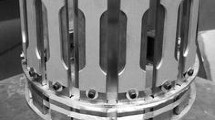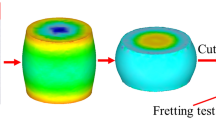Abstract
Influence of contact pressure and maximum cyclic stress (σmax) on the fretting fatigue behavior of modified 9Cr-1Mo steel has been studied using contact pads made of the same steel. The contact pressure was varied from 50 to 200 MPa using σmax of 400 and 500 MPa at a stress ratio (R) of 0.1. The fatigue life was observed to decrease in the presence of fretting action. For a given σmax the fretting fatigue life of the steel decreased with an increase in contact pressure up to 100 MPa beyond which saturation was observed. The ratio of slip to stick area increased with the contact pressure. This is in agreement with the increased depth of the fretting-induced debris and roughness.












Similar content being viewed by others
References
P.L. Hurricks, The Mechanism of Fretting—A Review, Wear, 1970, 15(6), p 389–409
R.B. Waterhouse, Fretting Fatigue, Mater. Sci. Eng., 1976, 25, p 201–206
R. Gnanamoorthy and R. Rosi Reddy, Fretting Fatigue in AISI 1015 Steel, Bull. Mater. Sci., 2002, 25(2), p 109–114
J.M. Wallace and R.W. Neu, Fretting Fatigue Crack Nucleation in Ti-6Al-4V, Fatigue Fract. Eng. Mater. Struct., 2003, 26(3), p 199–214
M. Jayaprakash and S. Ganesh Sundara Raman, Influence of Pad Span on Fretting Fatigue Behaviour of AISI 304 Stainless Steel, J. Mater. Sci., 2007, 42(12), p 4308–4315
S. Ganesh Sundara Raman and M. Jayaprakash, Plain Fatigue and Fretting Fatigue Behaviour of AISI 304 Austenitic Stainless Steel, Mater. Sci. Technol., 2007, 23(1), p 45–54
M. Jayaprakash, Y. Mutoh, K. Asai, K. Ichikawa, and S. Sukarai, Effect of Contact Pad Rigidity on Fretting Fatigue Behavior of NiCrMoV Turbine Steel, Int. J. Fatigue, 2010, 32(11), p 1788–1794
G.L. Goss and D.W. Hoeppner, Normal Load Effects in Fretting Fatigue of Titanium and Aluminum Alloys, Wear, 1974, 27(2), p 153–159
K. Iyer and S. Mall, Effects of Cyclic Frequency and Contact Pressure on Fretting Fatigue Under Two-Level Block Loading, Fatigue Fract. Eng. Mater. Struct., 2000, 23(4), p 335–346
K. Iyer and S. Mall, Analyses of Contact Pressure and Stress Amplitude Effects on Fretting Fatigue Life, J. Eng. Mater. Technol., 2001, 123(1), p 85–93
K. Nakazawa, N. Maruyama and T. Hanawa, Effect of Contact Pressure on Fretting Fatigue of Austenitic Stainless Steel, Tribol. Int., 2003, 36(2), p 79–85
H. Lee and S. Mall, Effect of Dissimilar Mating Materials and Contact Force on Fretting Fatigue Behavior of Ti-6Al-4V, Tribol. Int., 2004, 37(1), p 35–44
N.K.R. Naidu and S. Ganesh Sundara Raman, Effect of Contact Pressure on Fretting Fatigue Behaviour of Al-Mg-Si Alloy AA6061, Int. J. Fatigue, 2005, 27(3), p 283–291
R. Sadeler, Influence of Contact Pressure on Fretting Fatigue Behaviour of A.A. 2014 Alloy with Dissimilar Mating Material, Fatigue Fract. Eng. Mater. Struct., 2006, 29(12), p 1039–1044
G.Q. Wu, X.L. Liu, H.H. Li, W. Sha, and L.J. Huang, Effect of Contact Pressure on Fretting Fatigue Behavior of Ti-1023, Wear, 2015, 326, p 20–27
D. Takazaki, M. Kubota, R. Komoda, Y. Oku, T. Makino, and M. Sugino, Effect of Contact Pressure on Fretting Fatigue Failure of Oil-Well Pipe Material, Int. J. Fatigue, 2017, 101, p 67–74
V.K. Verma, H. Naseem, S. Ganesh Sundara Raman, H. Murthy, A.N. Majila, and D.C. Fernando, Effect of Contact Pressure and Stress Ratio on the Fretting Fatigue Behaviour of Ti-6Al-4V, Mater. Sci. Eng. A, 2017, 707, p 647–656
P. Kalyanasundaram, B. Raj, V. Prakash, and R. Ranga, Detection of Simulated Steam Leak into Sodium in Steam Generator of PFBR by Argon Injection Using Signal Analysis Techniques, Nucl. Technol., 2013, 182(3), p 249–258
Standard method of fretting fatigue testing, S015 (2nd edition), the Japan Society of Mechanical Engineers, 2009
G.L. Goss and D.W. Hoeppner, Characterization of Fretting Fatigue Damage by SEM Analysis, Wear, 1973, 24(1), p 77–95
K. Endo and H. Goto, Initiation and propagation of fretting fatigue cracks, Wear, 1976, 38(2), p 311–324
G.E. Dieter and D.J. Bacon, Mechanical Metallurgy, McGraw-Hill, New York, 1986
K. Nishioka and K. Hirakawa, Fundamental Investigations of Fretting Fatigue: Part 3, Some Phenomena and Mechanisms of Surface Cracks, Bull. JSME, 1969, 12(51), p 397–407
C.D. Lykins, S. Mall, and V.K. Jain, Combined Experimental–Numerical Investigation of Fretting Fatigue Crack Initiation, Int. J. Fatigue, 2001, 23(8), p 703–711
S.S. Samant, I.V. Singh, and R.N. Singh, Effect of Tempering and Rolling on Fatigue Crack Growth Behavior of Modified 9Cr-1Mo Steel, J. Mater. Eng. Perform., 2018, 27(11), p 5898–5912
D.A. Hills and D. Nowell, Mechanics of Fretting Fatigue, Springer, Berlin, 1994
S.K. Lee, K. Nakazawa, M. Sumita, and N. Maruyama, Effects of contact load and contact curvature radius of cylinder pad on fretting fatigue in high strength steel, Fretting Fatigue: Current Technology and Practices, ASTM Stock Numer: STP 1367, D.W. Hoeppner, V. Chandrasekaran,and C.B. Elliott III, Aug. 31, 1998 (University of Utah), ASTM International, 2000, pp 199–212
K. Nakazawa, K. Sumita, and N. Maruyama, Effect of contact pressure on fretting fatigue of high strength steel and titanium alloy, Standardization of fretting fatigue test methods and equipment, M.H. Attia and R.B. Waterhouse, ASTM International, 1992, pp. 115–125
Acknowledgments
The authors express their deep sense of gratitude to Dr. R. Divakar, Associate Director, Materials Engineering Group and Dr. M. Vasudevan, Head, Materials Development and Technology Division, IGCAR, for their keen interest and encouragement in this work.
Author information
Authors and Affiliations
Corresponding author
Additional information
Publisher's Note
Springer Nature remains neutral with regard to jurisdictional claims in published maps and institutional affiliations.
Rights and permissions
About this article
Cite this article
Shiva, V., Goyal, S., Parthasarathi, N.L. et al. Influence of Stress Ratio and Contact Pressure on Fretting Fatigue Behavior of Modified 9Cr-1Mo Steel. J. of Materi Eng and Perform 30, 2822–2831 (2021). https://doi.org/10.1007/s11665-021-05581-y
Received:
Revised:
Accepted:
Published:
Issue Date:
DOI: https://doi.org/10.1007/s11665-021-05581-y




